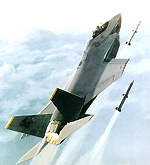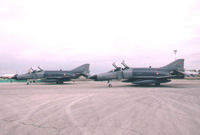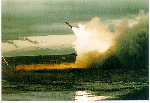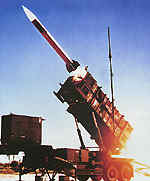|
 United
States invite Turkey to the production stage of Anglo-American next
generation Joint Strike Fighter (JSF) project as a FMS contender. It is
expected that US Defense Department will give the letter, which was
prepared officially for Turkish Government, to Turkey's deputy chief of
staff, Gen. Edip Baser during his visit to US. After the letter,
representatives of US giant defense industries rolled in JSF program;
Boeing, Lockheed Martin, General Electric and Pratt - Whitney will be in
Ankara on February, 14th-15th and negotiates with 26 Turkish Defense
Industries for possible contribution to production of JSF.
Undersecratariat for Turkish Defense Industries (SSM) has also invited
to related 26 Turkish companies to Turkish-US "industry day",
where the companies and US delegations will discuss the parts to be
produced and participation of Turkish industries. Turkey had decided to separate
$300 million budget and open a representative office for
following eight years for JSF project. United
States invite Turkey to the production stage of Anglo-American next
generation Joint Strike Fighter (JSF) project as a FMS contender. It is
expected that US Defense Department will give the letter, which was
prepared officially for Turkish Government, to Turkey's deputy chief of
staff, Gen. Edip Baser during his visit to US. After the letter,
representatives of US giant defense industries rolled in JSF program;
Boeing, Lockheed Martin, General Electric and Pratt - Whitney will be in
Ankara on February, 14th-15th and negotiates with 26 Turkish Defense
Industries for possible contribution to production of JSF.
Undersecratariat for Turkish Defense Industries (SSM) has also invited
to related 26 Turkish companies to Turkish-US "industry day",
where the companies and US delegations will discuss the parts to be
produced and participation of Turkish industries. Turkey had decided to separate
$300 million budget and open a representative office for
following eight years for JSF project.
 Undersecratariat for Turkish Defense Industries (SSM) announced that short-listed two
strong-bidders for Turkish AEW&C (THEIK) tender, Boeing 737-700/800
with Northrop Grumman MESA ESR and Airbus A310 with IAI/Elta Phalcon
PAR, will forward their last revised "Best and Final Offers
(BAFO)" until February, 10th. Final decision will be expected to
announced in first half of March. According to the $1.5 billion-project,
the awarded contender will deliver one ready-to-flight THEIK to Turkish
Air Forces (TuAF), remainder three will be delivered after completion of
structural modification, system installation, avionic installation and
software applications in Turkey by TAI, AsElSan and
HavElSan. Undersecratariat for Turkish Defense Industries (SSM) announced that short-listed two
strong-bidders for Turkish AEW&C (THEIK) tender, Boeing 737-700/800
with Northrop Grumman MESA ESR and Airbus A310 with IAI/Elta Phalcon
PAR, will forward their last revised "Best and Final Offers
(BAFO)" until February, 10th. Final decision will be expected to
announced in first half of March. According to the $1.5 billion-project,
the awarded contender will deliver one ready-to-flight THEIK to Turkish
Air Forces (TuAF), remainder three will be delivered after completion of
structural modification, system installation, avionic installation and
software applications in Turkey by TAI, AsElSan and
HavElSan.
In
the end of December, a long-awaited letter from the Turkish Treasury
notified the SSM that the Treasury will provide the loan guarantees
required to purchase four AEW&Cs, worth about $1.5 billion.
Companies competing in the project earned state credits from their
governments, and the Turkish Treasury will repay the principal capital
and interest.
 There
has been an ongoing rivalry for some time between
military-controlled Turkish Defense Ministry and the civilian-controlled
Defense Industries Undersecretariat (SSM). It has become obvious
that the military has made a move to further dominate defense
procurement. The appointment of two retired senior generals as
SSM deputy undersecretaries was part of the military's scheme to
bring the SSM under its direct control.
In addition to appointing retired generals as
undersecretaries, the General Staff is planning to
authorize the Defense Ministry rather than the SSM to handle the
direct purchase of eight additional S-70B Sea Hawk and four CH-60S
Knight Hawk helicopters from Sikorsky. There
has been an ongoing rivalry for some time between
military-controlled Turkish Defense Ministry and the civilian-controlled
Defense Industries Undersecretariat (SSM). It has become obvious
that the military has made a move to further dominate defense
procurement. The appointment of two retired senior generals as
SSM deputy undersecretaries was part of the military's scheme to
bring the SSM under its direct control.
In addition to appointing retired generals as
undersecretaries, the General Staff is planning to
authorize the Defense Ministry rather than the SSM to handle the
direct purchase of eight additional S-70B Sea Hawk and four CH-60S
Knight Hawk helicopters from Sikorsky.
The Defense Ministry and the SSM are holding negotiations to
establish a new directorate to redefine responsibilities in
procurement and joint co-production projects.
The main purpose of the negotiations is to subordinate the SSM to
the Defense Ministry, therefore ending its relatively autonomous
status, claim industry sources.
Turkey's defense ministers are civilians, whereas the rest of
the ministry consists mainly of military officers.
The ministry's military officers have for some time been
complaining about the existence of two undersecretaries -- one
being the SSM's civilian head and the other, the Defense
Ministry's undersecretary -- in defense industry procurement and
joint production projects. Senior officers in the ministry have
argued that there has been duplication, with projects being
carried out by both the SSM and the ministry.
The Defense Ministry wants to replace the SSM, staffed with
civilian engineers and scientists, most probably with a National
Armaments Directorate.
The SSM budget has been a source of friction between the army
and civilians. If the SSM is directly controlled by the Defense
Ministry, the ministry's budget will increase by 50%. Each
spends around $1.5 billion per year on direct purchases and joint
production projects.
 The first two upgraded F-4 warplanes was delivered to the Turkish Air
Force (TAF) from Israeli IAI/Elta/Elbit team. The aircraft, which
are the first of 26 fighter jets to be modernized in Israel, will
be unveiled at a special ceremony at the Eskisehir Air Force
Base. According
to an agreement with Israel, 26 F-4s, out of a total of 54, will
be upgraded in Tel Aviv by Israel Aircraft Industries. The
modernized fighters have new radar equipment, aviation
electronics, structural modification, enhanced engine power and
stand-off weapons were added so they can be used in a deep-strike
role in the next 15-20 years. The remaining 28 aircraft will be
upgraded at the Eskisehir base. Modernization
of the two F-4s has been completed with the contribution of
Turkish officials within the framework of the agreement. The
improvements to the F-4s will allow them to stay in service until
2020.
The first two upgraded F-4 warplanes was delivered to the Turkish Air
Force (TAF) from Israeli IAI/Elta/Elbit team. The aircraft, which
are the first of 26 fighter jets to be modernized in Israel, will
be unveiled at a special ceremony at the Eskisehir Air Force
Base. According
to an agreement with Israel, 26 F-4s, out of a total of 54, will
be upgraded in Tel Aviv by Israel Aircraft Industries. The
modernized fighters have new radar equipment, aviation
electronics, structural modification, enhanced engine power and
stand-off weapons were added so they can be used in a deep-strike
role in the next 15-20 years. The remaining 28 aircraft will be
upgraded at the Eskisehir base. Modernization
of the two F-4s has been completed with the contribution of
Turkish officials within the framework of the agreement. The
improvements to the F-4s will allow them to stay in service until
2020.
The first defense industry project launched between Turkey and Israel was a
modernization 26 of Turkey's 54 F-4Es to bring them up to Phantom 2000 standards and is being carried out by Israeli Aircraft Industries (IAI).
The project's $670 million price tag is being financed by an Israeli state credit. The project began
on January 1997 and is scheduled for completion on February 2003.
A further 28 F-4s will be updated on May, 2000 at Turkey's Eskisehir facilities as part of a technology transfer agreement.
The F-4s will be equipped with Israeli-made Elta EL-2032 SAR (Synthetic Aperture
Radar), Elbit active ECM and Mikes Rapport III derivative
passive ECM. The suitability of the radar as well as the cost of the project were questioned by the public before the signing of the contract.
Israel's IAI modernization of the 26 Turkish F-4s will equip the aircraft with 46 AGM-142 Popeye
1 medium-range stand-off air-to-surface missiles in one-and-a-half year's time from Israel's Rafael under a $100 million deal signed in October of last year.
Second Batch 28 F-4T 2020 will be equipped with 54 Popeye 1
missiles.
After completion of F-4T 2020
program, the unmodified relicts of F-4Es (around 100) will be
replaced by next generation fighter in mid-first decade of 21st.
century. Possible candidates are F-16C/D Block 60, Typhoon, F-15E
and ex-USAF F-15s.
 The
Naval Forces Command is decided to begin negotiations with
Sikorsky to buy second batch eight more S-70B28+ (SH-60) Sea
Hawks as well as four CH-60s Knight Hawk required for logistical
cargo and carrying personnel. The project will be financed
through U.S Ex-Im Bank credit set up in the 1990s for Turkey's
purchase of Black Hawk S-70A28 utility helicopters. The General
Staff agreed to allow the navy to use the remaining Ex-Im Bank
credit, $350 million, for its additional Sea Hawk purchase.
Total requirement of Sea Hawk and Knight H Hawk of Turkish Naval
Forces are 32 and 12 respectively. The
Naval Forces Command is decided to begin negotiations with
Sikorsky to buy second batch eight more S-70B28+ (SH-60) Sea
Hawks as well as four CH-60s Knight Hawk required for logistical
cargo and carrying personnel. The project will be financed
through U.S Ex-Im Bank credit set up in the 1990s for Turkey's
purchase of Black Hawk S-70A28 utility helicopters. The General
Staff agreed to allow the navy to use the remaining Ex-Im Bank
credit, $350 million, for its additional Sea Hawk purchase.
Total requirement of Sea Hawk and Knight H Hawk of Turkish Naval
Forces are 32 and 12 respectively.
By the end
of the year Turkey expects to receive the first of a planned 32
Sea Hawks from an earlier batch of eight Sea Hawks approved by
the U.S. Congress. Norway's decision in late December last year
to lift a ban on the sale of Penguin helicopter-launched
anti-ship missiles to Turkey will enable the Turkish Navy to
equip the Sea Hawks with Kongsberg Defense and Aerospace-made
Penguins. The deal involves the sale
of 16 Penguin Mk Mod 7 anti-ship missiles to Turkey worth NKn 305
million. The agreement includes an option worth NKn 150 million.
The availability of the Penguins means the Turkish Navy will drop
its plans to seek alternative missiles such as Harpoons and
Polyphems for deployment on its Sea Hawk helicopters.
 Rockwell Collins is providing the avionics to upgrade 58
Sikorsky Aircraft Corporation S-70D-28 Black Hawk helicopter (50 new
Batch II S-70D-28s of Land Forces and 8 S-70A-28 CSARs of Special
Forces) cockpits. The $28 million award represents the first application of the newly designed
cockpit selected by the Turkish Armed Forces. Rockwell Collins is providing the avionics to upgrade 58
Sikorsky Aircraft Corporation S-70D-28 Black Hawk helicopter (50 new
Batch II S-70D-28s of Land Forces and 8 S-70A-28 CSARs of Special
Forces) cockpits. The $28 million award represents the first application of the newly designed
cockpit selected by the Turkish Armed Forces.
The cockpit features four 6 x 8 inch multifunction displays (MFD), dual flight management system (FMS) with integrated control of the flight
director and an instrument panel that has been reduced in width to improve
pilot field of view. It also includes weather radar, providing advance indication of turbulent weather conditions with flight path overlay.
The cockpit can be equipped with Forward Looking Infra-red (FLIR), allowing
the pilot to operate through decreased visibility conditions and at night,
and a moving digital map, displaying real-time aircraft position and surrounding information.
 Turkey
abandoned its
plans to carry out the 3.5th generation Turkish Tank-2000 Main
Battle Tank co-production and the
modernization of the renewable M-60 and Leopard I projects in parallel.
The decision came as the Tank-2000 project has been moving slower, while the tanks in the
Land Forces Command inventory are due to be obsolete early this
century. The Land Forces Command 4,280 main
battle tank fleet consists of M-48A5T1/2, M-60A1/3 and Leopard I series
tanks. Turkey is considering upgrading around 1,000 M-60A1& A3
MBTs. A total
of 162 of 330 Leopard 1s in the inventory will also be upgraded. Turkey
abandoned its
plans to carry out the 3.5th generation Turkish Tank-2000 Main
Battle Tank co-production and the
modernization of the renewable M-60 and Leopard I projects in parallel.
The decision came as the Tank-2000 project has been moving slower, while the tanks in the
Land Forces Command inventory are due to be obsolete early this
century. The Land Forces Command 4,280 main
battle tank fleet consists of M-48A5T1/2, M-60A1/3 and Leopard I series
tanks. Turkey is considering upgrading around 1,000 M-60A1& A3
MBTs. A total
of 162 of 330 Leopard 1s in the inventory will also be upgraded.
Until
recently the Land Forces Command plan was to implement the
Tank-2000 MBT co-production and the modernization in parallel to
minimize problems that may occur from maintenance and supply
investments in a modern tank. The capabilities to be gained were
planned to be used in the modernization of the tanks in the
inventory. Turkey's change in this concept may also be due to the
emerging view within the Land Forces Command to go with its
favorite KWM/Otokar Leopard IIA6 tanks. If this speculation turns out to be
correct then the early modernization of the U.S.-made M-60 tanks
has come up to the agenda. Ruling out this speculation a local
industry source, said, however, that it has now been realized
that, for example, the company winning the contract would not
necessarily have had similar systems to upgrade the M-60s. Turkey's deputy chief of
staff was in Israel late in December 1999 for the
biannual strategic talks, and the technical team accompanying him
held negotiations with Israeli Military Industries (IMI) for
modular SABRA kits over the M-60
upgrade, according to a military source.
Though the same source said that
Requests for Proposals may be issued to stir the competition
rather than going to one company, it is understood that Israeli
Military Industries, which long ago made an offer to the Land
Forces Command, is favored for the modernization. General
Dynamics Land System also support the IMI for the M-60 modernization
project. Meanwhile, SSM
and Aselsan have been working jointly on the details of the
modernization of the Leopard I tanks. A source said that since
Leopard tanks involve the upgrading of fire control systems
Aselsan may carry out the upgrading by importing its spares from
abroad.
 The
range of the locally developed Toros 230 rocket system, ready for
production stage, has been increased from 65 km to 100 km. The new
and larger variant Toros 260 is produced by the Defense Industry
Research and Development Institute (SAGE), which operates under the
auspices of the Turkish Scientific and Technical Research Association
(TUBITAK). The
range of the locally developed Toros 230 rocket system, ready for
production stage, has been increased from 65 km to 100 km. The new
and larger variant Toros 260 is produced by the Defense Industry
Research and Development Institute (SAGE), which operates under the
auspices of the Turkish Scientific and Technical Research Association
(TUBITAK).
TUBITAK representatives reported that the
preliminary tests on the new Toros 260 had been successfully completed
and that the first operational test will be held in Istanbul's Sile
county some time in February or March 2000. The rocket will also be
launched during this period. The new Toros 260 canon system has the
capability of launching eight rockets per minute. The rockets
themselves, which are 1.45 meters in length, are fully effective within
a 105 meters-radius of the targeted area, and shrapnel from the missile
affects an 151 meters-radius area. The system can be operated by one
person. TUBITAK SAGE experts are working hard to produce war heads and a
missile-guidance system for the Toros 260, which will later be
integrated into the system so that it may become competitive on the
world market.
 Turkish
Armed Forces (TSK) officers are said to be divided into three groups
over what kind of ballistic missile strategy they should be pursuing now
that the potential ballistic missile threat from Turkey's southern and
southeastern neighbors (Syria and Iran), has become a real problem for
Ankara. 1) One group of officers prefers to go with the NATO missile
program which is currently moving very slowly. 2) Some others argue
that Turkey should secure an offensive missile system to be a sufficient
deterrent. But this would be contradiction of international agreements,
to which Turkey is a signatory, banning the proliferation of such
weapons. For example, it was only after the Turkish Parliament's
ratification of the Comprehensive Test Ban Treaty (CTBT) that the United
States initialed a protocol in Ankara on November 1999 under which the
operation of a seismic monitoring station was transferred to Turkey. 3)
The third group comprises those who seem to be more realistic and favor
obtaining defensive systems. They say Turkey has to be quick in taking
steps to obtain anti-ballistic missile systems. And this is the
prevailing view among these three different sets of opinions. They say
that Turkey, in cooperation with the United States and Israel, should
solve the problem of the ballistic missile threat. Turkish
Armed Forces (TSK) officers are said to be divided into three groups
over what kind of ballistic missile strategy they should be pursuing now
that the potential ballistic missile threat from Turkey's southern and
southeastern neighbors (Syria and Iran), has become a real problem for
Ankara. 1) One group of officers prefers to go with the NATO missile
program which is currently moving very slowly. 2) Some others argue
that Turkey should secure an offensive missile system to be a sufficient
deterrent. But this would be contradiction of international agreements,
to which Turkey is a signatory, banning the proliferation of such
weapons. For example, it was only after the Turkish Parliament's
ratification of the Comprehensive Test Ban Treaty (CTBT) that the United
States initialed a protocol in Ankara on November 1999 under which the
operation of a seismic monitoring station was transferred to Turkey. 3)
The third group comprises those who seem to be more realistic and favor
obtaining defensive systems. They say Turkey has to be quick in taking
steps to obtain anti-ballistic missile systems. And this is the
prevailing view among these three different sets of opinions. They say
that Turkey, in cooperation with the United States and Israel, should
solve the problem of the ballistic missile threat.
However,
the obtaining such missile systems causes the biggest obstacle from its
main ally, the United States. "The Israelis have Arrow I and II
ATBM systems, for example. We have the Patriot PAC-3 and THAAD system.
This does not necessarily mean that we are going to transfer these kinds
of systems to Turkey," stressed a U.S. official during a meeting
with a group of Turkish journalists. But Washington agrees that Turkey
has the legitimate right to acquire anti-ballistic missiles due to the
threatening nature of its regional ballistic missile environment. In
this context a group of Turkish officers is to take part in a simulated
theater defense exercise under the auspices of the U.S.-Turkish
bilateral working group on theater missile defense (anti
surface-to-surface missiles systems). The exercise will take place
between January, 26th and 27th in Baltimore.
The United States has
emphasized that such bilateral meetings are not designed to help Turkey
develop an independent theater missile capability, but to educate
Turkish officers on the antiballistic missile systems available in the
region. The activities involve war fighting laboratory exercises of
various theater missile defense scenarios. This will be the second time
Turkey and the United States have met to familiarize Turkish officers
with the threats posed by ballistic missiles. A group of Turkish
officers took part in a planning conference on theater missile defense
organized by the United States last November. The United States will
also listen to the Turkish side on the content of its deliberations
during the biannual strategic talks with Israel, held at senior officer
level last December. Turkey is seeking antiballistic missile technology,
but the United States is reluctant to involve Turkey in the joint
U.S.-Israeli Arrow II program. During late January talks between the
United States and the Turkish officers, Turkey's possible procurement of
the U.S.-Israeli Arrow II anti-tactical ballistic missile system will
also be discussed.
Turkey
is also strongly interested with wide range of spectrum of
offensive/defensive ballistic defense systems as Israeli Delilah
long-range (500km) anti-radiation stand-off cruise missile/drone, Israeli
Homa (Wall) ground-based
long-range early warning radar system, Israeli Harpy anti-radiation
UAVC, Israeli-US airborne Tactical High Energy Laser (THEL) systems,
Israeli Jericho series ballistic missiles, 180km.-range Chinese WS-1B
MRL -advanced version of previously acquired 6-battery of WS-1), US
Patriot PAC-3 and earlier versions. Turkey also currently negotiates
with Israel about co-operation to Ofek military satellite and with
France for acquiring 18 IHAWK PIPII missile system, which will cost
about $160 million-cost.
 A
Sikorsky S-70A(D)28 of 20 newly arrived second batch Black Hawk crashed
during training fly in Palm Beach, US. The aircrew, one US trainer and
two Turkish staff, were injured in little degrees. The crashed Black
Hawk is one of the 10 recently acquired S-70s found in US for training
stage. Other 10 were delivered to Turkey a few months ago. Reminder 30
S-70D28 will be delivered to Turkey in 2000-01. The total cost of the 50
Second Batch S-70A(D)28 is ca. $550 million. Because the low-damage
conditions, the crashed Black Hawk can be repaired to fly-again. A
Sikorsky S-70A(D)28 of 20 newly arrived second batch Black Hawk crashed
during training fly in Palm Beach, US. The aircrew, one US trainer and
two Turkish staff, were injured in little degrees. The crashed Black
Hawk is one of the 10 recently acquired S-70s found in US for training
stage. Other 10 were delivered to Turkey a few months ago. Reminder 30
S-70D28 will be delivered to Turkey in 2000-01. The total cost of the 50
Second Batch S-70A(D)28 is ca. $550 million. Because the low-damage
conditions, the crashed Black Hawk can be repaired to fly-again.
|